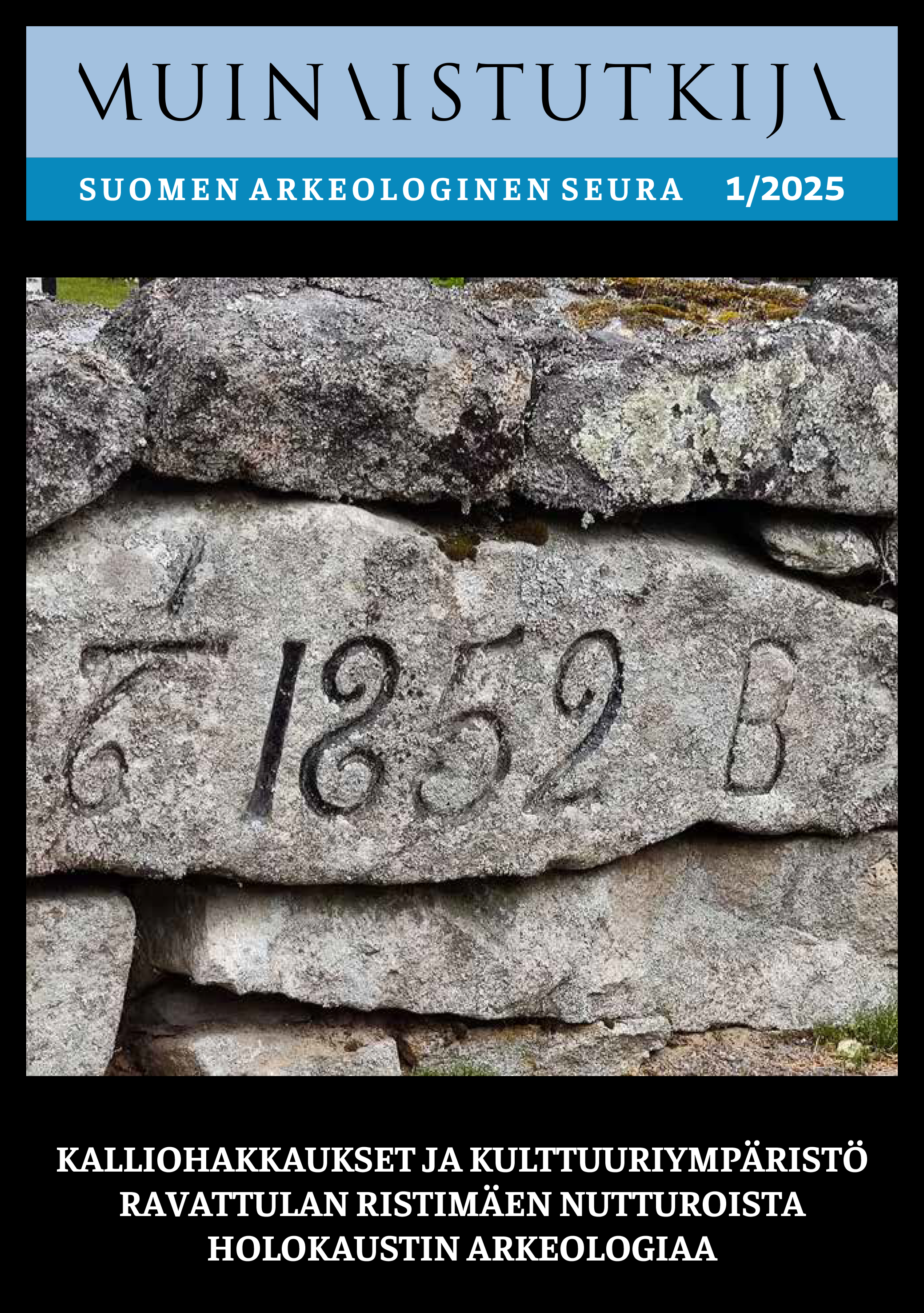Holokaustin arkeologiaa Unkarissa ja Hollannissa
eroja idän ja lännen tutkimustraditioissa
Authors
Tiedostot
Näytä PDF
Julkaistu numerossa Vol 42 Nro 1 (2025) julkaisussa Muinaistutkija.
Muinaistutkija on Suomen arkeologisen seuran julkaisema lehti, joka julkaisee arkeologista tutkimusta ja muita arkeologiaan liittyviä tekstejä ensisijaisesti kotimaisilla kielillä.
ISSN 2489-785X (verkkojulkaisu)
Taittopohjan ja kannen suunnittelu: Ville Korkiakangas
Lehteen voi lähettää vertaisarvioitavia artikkeleita ja muita tekstejä pitkin vuotta. Sen jälkeen, kun tekstit on hyväksytty julkaistavaksi, ne ilmestyvät seuraavassa numerossa.
Kuuntele Muinaistutkijan arkeologia podcastia Spotifyssa tai Apple Podcastissa.
Abstrakti
Tämä artikkeli on tiivistelmä maisterintutkielmastani ja se käsittelee Unkarin ja Hollannin holokaustin arkeologista tutkimustraditiota holokaustin uhrien keräys- ja säilytyspaikkojen näkökulmasta. Artikkelissa tarkastellaan, miten arkeologinen tutkimus on toteutunut valituissa kohdemaissa ja vertaillaan tehtyä tutkimusta keskenään.
Tiedostot
Näytä PDFLähdeviitteet
Bartosiewicz, L., Mérai, D. & Csippán, P. 2011. Dig Up–Dig in: Practice and Theory in Hungarian Archaeology. L. Lozny (toim.) Comparative Archaeologies: A Sociological View of the Science of the Past: 273–337. New York: Springer. https://doi:10.1007/978-1-4419-8225-4_11
Bernbeck, R. & Pollock, S. 2018. Quotidian and Transgressive Practices in Nazi Forced Labor Camps: The Role of Objects. International Journal of Historical Archaeology 22(1): 1–18. https://doi:10.1007/s10761-017-0434-1
Boon, H. 2016. Archeologisch onderzoek barak 56 zuidzijde te Kamp Westerbork. Bureauonderzoek Sweco Archeologische Rapporten.
Borgman, T. 2024. Magyar gettók & Westerbork van Nederland: Vertaileva tutkimus: Hollannin ja Unkarin holokaustin uhrien keräys- ja säilytyspaikkojen tutkimustraditio holokaustin arkeologian näkökulmasta. Pro gradu -tutkielma, Arkeologia, Helsingin yliopisto.
Braham, R.L. 2013. Foreword. Zoltán, V., László, C. & Gábor, K. The Holocaust in Hungary: Evolution of a Genocide: xvii-xxi. Maryland: AltaMira Press.
Braham, R.L. & Kovács, A. 2016. The Holocaust in Hungary: Seventy Years Later. New York: Central European University Press.
Burds, L.T., Beck, J.D., Mataitis, R.J., Jol, H.M., Freund, R.A., McClymont, A.F. & Bauman, P. 2018. Holocaust Archaeology: Using Ground Penetrating Radar to Locate a Jewish Mass Grave in Kaunas, Lithuania. 17th International Conference on Ground Penetrating Radar (GPR): 1–4. Rapperswil, Switzerland. https://doi:10.1109/ICGPR.2018.8441590
Carr, G. 2018. The Small Things of Life and Death: An Exploration of Value and Meaning in the Material Culture of Nazi Camps. International Journal of Historical Archaeology 22(3): 531–552. https://doi:10.1007/s10761-017-0435-0
Cherkaska, D., Colls, C.S., & Colls, K. 2022. Archaeological approaches in investigations of Holocaust-related mass graves: A Ukrainian Perspective. Ukraina Moderna 35(1): 89–123.
Colls, C.S. 2012. Holocaust archaeology: archaeological approaches to landscapes of Nazi genocide and persecution. Journal of Conflict Archaeology 7(2):70–104. https://doi:10.1179/1574077312Z.0000000005
Colls, C.S. 2015. Holocaust archaeologies: approaches and future directions. London: Springer.
Colls, C.S. & Branthwaite, M. 2018. “This is proof”? Forensic evidence and ambiguous material culture at Treblinka extermination camp. International Journal of Historical Archaeology 22(3): 430–453. https://doi:10.1007/s10761-017-0432-3
De Haan, I. 1998. The Construction of a National Trauma. The Memory of the Persecution of the Jews in the Netherlands. Netherlands Journal of Social Sciences 34(2): 196–217.
De Haan, I. 2008. Breuklijnen in de geschiedschrijving van de Jodenvervolging. Een overzicht van het recente Nederlandse debat. Low Countries Historical Review 123(1): 31–70. https://doi:10.18352/bmgn-lchr.6733
Etu-Sihvola, H. 2019. Holokaustin arkeologian lyhyt historia. Kalmistopiiri. https://kalmistopiiri.fi/2019/10/22/holokaustin-arkeologian-lyhyt-historia/ (Luettu 23.9.2024)
Etu-Sihvola, H. & Moilanen, U. 2020. Romanien historiaa ja arkeologiaa. Kalmistopiiri. https://kalmistopiiri.fi/2020/04/08/romanien-historiaa-ja-arkeologiaa/ (Luettu 23.9.2024)
Freund, R. A. 2019. The Archaeology of the Holocaust: Vilna, Rhodes, and Escape Tunnels. London: Rowman & Littlefield.
Fritz, R. 2015 Inside the Ghetto: Everyday Life in Hungarian Ghettos. Bern: Universität Bern.
Gilead, I. 2014. Archaeology of the Holocaust. Témoigner. Entre histoire et mémoire. Revue pluridisciplinaire de la Fondation Auschwitz 119. <https://journals.openedition.org/temoigner/1486?lang=en#quotation> (Luettu 20.9.2024)
Gilead, I., Haimi, Y. & Mazurek, W. 2010. Excavating Nazi Extermination Centres. Present Pasts 1: 10–39. https://doi:10.5334/pp.12
Hraskó, I. 2018. Az egykori kecskeméti gettó egyik helyszínén zajlik ásatás. Bács-Kiskun Megyei Hírportál. <https://www.baon.hu/helyi-kozelet/2018/12/az-egykori-kecskemeti-getto-egyik-helyszinen-zajlik-asatas#google_vignette> (Luettu 20.9.2023)
Huhák, H. & Szécsényi, A. (toim.) 2015. A Holokauszt Emlékközpont gyüjteményi katalógusa. Budapest: HDKE.
IHRA 2024. Holocaust sites under threat to benefit from new IHRA Charter for Safeguarding Sites. International Holocaust Remembrance Alliance. <https://holocaustremembrance.com/news/ihra-charter-safeguarding-sites-launch> (Luettu 23.8.2024)
Isaac, K.R. & Çakmak, E. 2012. Understanding visitor’s motivation at sites of death and disaster: the case of former transit camp Westerbork, the Netherlands. Current Issues in Tourism 17(2): 164–179. https://doi:1080/13683500.2013.776021
Jasinski, M.E. 2013. Reinforced concrete, steel and slaves: Archaeological studies of prisoners of World War II in Norway – The case of Romsdal Peninsula. H. Mytum & G. Carr (toim.) Prisoners of war: Archaeology, memory and heritage of 19th- and 20th-century mass internment: 145–165. New York: Springer. https://doi:10.1007/978-1-4614-4166-3_9
Kangasmaa, A. 2021. Juridinen näkökulma toisen maailmansodan sotavainajien etsintään ja arkeologiseen kaivamiseen Suomessa. Kalmistopiiri. <https://kalmistopiiri.fi/2021/08/04/juridinen-nakokulma-toisen-maailmansodan-sotavainajien-etsintaan-ja-arkeologiseen-kaivamiseen-suomessa/> (Luettu 12.5.2024)
László, C. 2010. Tettesek, Szemtanúk, Áldozatok a Vészkorszak Jász-Nagykun-Szolnok Megyében. Väitöskirja. Szegedin yliopisto.
László, C. & Gellért, A. 2017. Holocaust Research and Infrastructure in Hungary. Studies on the Holocaust 31(2): 146–154. https://doi:10.1080/23256249.2017.1346750
McClymont, A. F., Bauman, P. D., Freund, R. A., Seligman, J., Jol, H. M., Reeder, P., Bensimon, K. & Vengalis, R. 2022. Preserving Holocaust history: Geophysical investigations at the Ponary (Paneriai) extermination site. Society of Exploration Geophysicists 87(1): WA15-WA25. https://doi:10.1190/geo2021-0065.1
Miklóssy, K. 2021. Kulttuuritaistelu muistin hegemoniasta Unkarissa ja Puolassa. Historiallinen Aikakauskirja 119(4): 432–444. https://doi:https://doi.org/10.54331/haik.113157
Prenger, K. 2021. Camp Westerbork. Traces of War. STIWOT (Stichting Informatie Wereldoorlog Twee). <https://www.tracesofwar.com/articles/4439/Camp-Westerbork.htm> (Luettu 12.4.2024)
Ranta, T. 2020. Kun sota tulee iholle – Turistina Ilomantsin sotahistoriallisilla kohteilla. Kalmistopiiri. <https://kalmistopiiri.fi/2020/08/18/kun-sota-tulee-iholle-turistina-ilomantsin-sotahistoriallisilla-kohteilla/#comments> (Luettu 12.9.2024)
Roberts, M. R. 2010. ‘Footprints in the Concrete’: A Study of the Chemin des Juifs (Jews’ Road), Jewish Slave Labour Camps, and Related Sites, in the Nord-Pas-de-Calais, France. The Historic Environment: Policy & Practice 1(1): 70–102. https://doi:10.1179/175675010X12662480109153
Schute, I. 2010. Archeologisch onderzoek naar de koepelkazematten G16 en G18 op de Grebbeberg. Gemeente Rhenen (RAAP-rapport 2127). Weesp: RAAP Archeologisch Adviesbureau.
Schute, I. 2013. De vuilstort van Kamp Westerbork. Gemeente Aa en Hunze. Een archeologisch onderzoek. The Westerbork Archaeological Research Project Volume 2 (RAAP-rapport 2575). Weesp: RAAP Archeologisch Adviesbureau.
Schute, I. & Wijnen, J. 2012. De villa van Kamp Westerbork. Hooghalen, gemeente Midden-Drenthe. Een archeologisch en bouwbiografisch onderzoek. The Westerbork Archaeological Research Project Volume 1 (RAAP-Rapport 2550). Weesp: RAAP Archeologisch Adviesbureau.
Schute, I., Wijnen J. & Kok, R. 2016. Conflict Archaeology in the Netherlands: The Role of Communities in an Emerging Archaeological Discipline. Journal of Community Archaeology & Heritage 3(1): 22–39. https://doi:10.1080/20518196.2015.1123889
Seitsonen, O. 2018. Archaeologies and Heritage of the Second World War German Military Presence in Finnish Lapland. Väitöskirja, Arkeologia, Oulun yliopisto.
Seitsonen, O. & Herva, V.-P. 2011. Forgotten in the Wilderness: WWII PoW Camps in Finnish Lapland. A. Myers & G. Moshenska (toim.) Archaeologies of Internment: 171–190. New York: Springer. https://doi:10.1007/978-1-4419-9666-4_10
Stamnes, A. 2012. Geophysical survey at the Second World War Prison Camp at Falstad, Ekne in Levanger Municipality. Norwegian University of Science and Technology, Section for Archaeology and Cultural History, NTNU Museum of Archaeology and Natural History. https://www.academia.edu/10156438/Geophysical Survey at the Second World War Prison Camp at Falstad, Ekne in Levanger Municipality, Norway (Luettu 9.2.2025)
Susa, É., Éry, K., Kovács, L., Szőke, M. & Molnos, M. 2015. Forensic archeology and anthropology in Hungary: current trends and future perspectives. W.J.M. Groen, N. Márquez-Grant & R.C. Janaway (toim.) Forensic Archaeology: A Global Perspective: 83–90. Oxford: Wiley Blackwell. https://doi:10.1002/9781118745977.ch11
Thomas, S.E., Herva, V.-P., Seitsonen, O., Koskinen-Koivisto, E. 2019. Dark Heritage. C. Smith (toim.) Encyclopedia of Global Archaeology. New York: Springer. https://doi:10.1007/978-3-319-51726-1_3197-1
Vařeka, P. 2023. Archaeology of Zigeunerlager Results of the 2018–2019 investigation at the Roma detention camp in Lety. Heritage Memory and Conflict. Z. Dziuban & R. van der Laarse (toim.) Accessing Campscapes: Critical Approaches and Inclusive Strategies for European Conflicted Pasts. Heritage, Memory and Conflict 3: 31–38. https://doi:https://doi.org/10.3897/hmc.3.84017
Väisänen, T., Härmä, S.-V. & Fagerholm, F. 2021. Varjojen aika: Esittelyssä konfliktiarkeologinen lukiolaiskaivaus Porin metsässä. Muinaistutkija 1/2021: 2–11.
Weiss, A. 2003. A monumental failure at Belzec. Forward, 11.4.2003. <https://forward.com/opinion/8594/a-monumental-failure-at-belzec/> (Luettu 12.5.2024)
Fast, J. 2024. Deutsches Lager Hanko 1942–1944. The Modern Conflict Archaeology and History of a German Second World War Transition Camp in Hanko, South Finland. Väitöskirja, Arkeologia, Helsingin yliopisto.
Zohar, E. 2021. The Jewish resistance and their use of the subterranean dimension in the Będzin and Sosnowiec ghettos. Holocaust Studies 29(1): 66–115. https://doi:10.1080/17504902.2021.1992914
Tiedot
| DOI | |
|---|---|
| Julkaistu |
30. huhtikuuta 2025
|
| Numero | |
| Osasto |
Vertaisarvioimattomat artikkelit
|
| Lisenssi |


